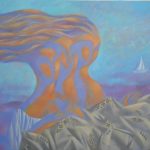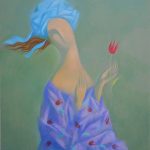
Being a faculty member at the Faculty of Architecture and Fine Arts and Design of Near East University, Assoc. Prof. Rana Amrahova made artworks titled “Tulip”, “Lefkara” and “Temple” on her canvas for the Cyprus Museum of Modern Arts and presented them to the taste of art lovers.
The symbol of Ottoman art, the tulip flower
Artist Amrahova emphasizes her feelings with tulip flower, one of the symbols of Ottoman art, reflecting the beauty, affection and elegance of the Turkish woman on her canvas in her work titled “Tulip”. The painting was made with oil painting technique, using soft pastel colors, subtle color and tone transitions, and flowing lines express the artist’s desire to show the sensitivity of the feminine nature.
Traditional embroidery of Cypriot women Lefkara
In another of her work, “Lefkara”, she depicts “Lefkara”, which is the traditional Cypriot embroidery of Cypriot women. In this work made with the oil painting technique, the white ship figure in the sea reflects the longing expectations of the lovers. The female figures have been painted in contrasting and bright colors. The sun brightly illuminates women’s faces. Against the background of a calm seascape and linen embroidery hues, bright female figures stand out with their expressions and vitality. With this, the artist conveys women to the audience as a force that creates and drives life.
Temple of spirituality and greatness for all cultures
In her latest work, “Temple”, the artist symbolically depicts a temple, emphasizing that the temples created by people’s labor and prayers are places of spirituality and greatness for all cultures. The temple is symbolically depicted in the shape of a rising triangle, with the faces and hands of the people showing the labor and spiritual power of the creators. Artist Amrahova tries to show the beauty and power of the human spirit and creativity, reflecting the human connection with the earth with golden, warm and earth tones. The upward diagonal lines and details of the work also show her desire to attain supreme values.
Who is RanaAmrahova?
Rana Amrahova was born on October 26, 1965, in Baku, the capital city of Azerbaijan. From 1980 to 1984, she received her art education at Azerbaijan State College of Fine Arts named after Azim Azimzadeh. She received her undergraduate and graduate education at the Department of Painting of Moscow State Academic Art institute named after V. I. Surikov between the years 1984-1990. In 1997, she became a member of the Union of Artists of Azerbaijan. Between years of 2001-2006, she worked as a faculty member at the Department of Academic Design of Azerbaijan State Academy of Fine Arts. In the academic year of 2006-2007, she worked as a lecturer at the Department of Architecture, Department of Interior Design and the Department of Graphic Design of the International Cyprus University.
The artist, who received the title of associate professor in 2008 via the Senate decision of the Azerbaijan State Academy of Fine Arts, was awarded an associate professor diploma by the Azerbaijan State Attestation Commission in 2010. She has been working as a lecturer at the Faculty of Architecture and the Faculty of Fine Arts and Design of Near East University since 2016.
The artist has taken part in the organization of various artistic and academic events so far. She has participated in many national and international exhibitions. In 2013, she participated in the 3rd Gabala International Art Exhibition held in Azerbaijan and awarded the “Inspirational Work” certificate. In 2015, she opened her solo exhibition at the exhibition center of Baku Museum of Modern Art.
Her works take place in the private collections in many countries as well as in the collection of Baku Modern Art Museum and Cyprus Museum of Modern Arts. She is the author of two textbooks respectively titled “Art of Design-Designing with light and shadow” and “Classic portrait design.”

